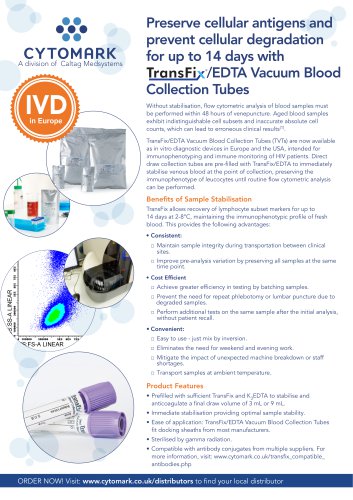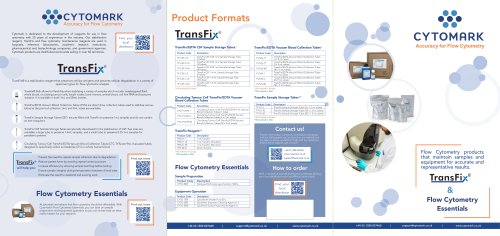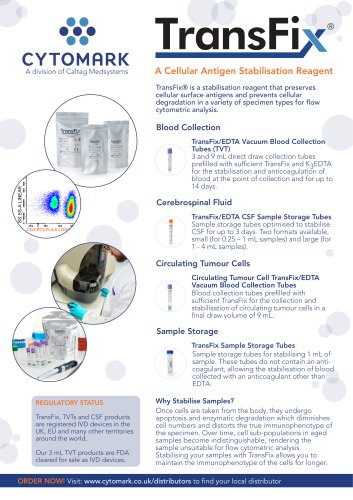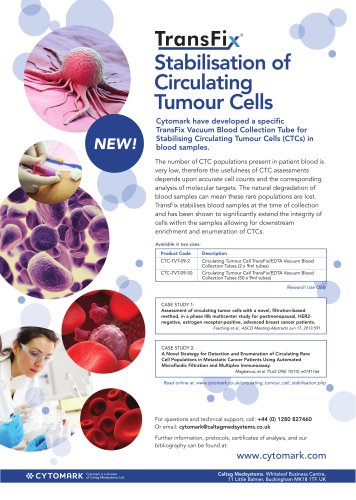 Website:
Cytomark Limited
Website:
Cytomark Limited
Catalog excerpts

• Standardisation of samples across multiple sites (all samples preserved at the same time point, all analysis can be performed at the same site). TransFix has been shown to reduce cellular lysis after 30 minutes compared to fresh CSF and to stabilise key CSF leucocyte markers for up to 72 hours (6). The stabilisation process preserves light scatter and key antigen expression patterns, including CD10, CD19, CD34, CD45, HLA-DR and CD117. Stabilise CSF with TransFix/EDTA CSF Sample Storage Tubes • Fewer patient recalls due to unusable sample. TransFix/EDTA CSF Sample Storage Tubes have been specifically optimised in collaboration with leading oncologist for CSF stabilisation and have been recommended in guidelines for CSF sample storage, published in the British Journal of Haematology (5). • Ensures sample integrity during transportation between clinical sites. o Eliminates the need for weekend and evening work. TransFix has been used for the stabilisation of malignant haematological cells found in CSF. Advantages of stabilising blood for immunophenotyping in clinical trials: o Easy to use - just add TransFix and mix by inversion. o Transport samples at ambient temperature. Clinical Trials Flow cytometry is proving to be useful in detecting malignant cell populations in cerebrospinal fluid (CSF), however low cell counts and rapid decline of cells after lumbar puncture can pose technical challenges for flow cytometric analysis (3) (4). o Reduces the impact of unexpected machine breakdown or staff shortages. Advantages for Immunophenotyping and HIV/AIDS immune monitoring: Leukemic infiltration of the Central Nervous System (CNS) is a sign that leucocytes have spread to the brain and spinal cord, and provides poor prognosis in diseases such as childhood acute lymphocytic leukaemia. Clinical Diagnosis and Monitoring • Further tests can be performed on the same sample after the initial analysis, without patient recall. • Ship samples to centralised reference laboratories without requiring cold chain transportation. • Batch samples for reduced pre-analysis variability. Circulating Tumour Cell Stabilisation – RUO Cerebrospinal Fluid Stabilisation – RUO o Reduction in pre-analysis variability – all samples preserved at the same time point. o Prevent the need for repeat phlebotomy due to degraded samples. o Ensures sample integrity during transportation between clinical sites. TransFi TransFix prevents cellular degradation of human whole blood for up to 14 days at huma 2-8°C, and for up to 4 days at ambient 2-8 temperature (18-25°C), maintaining the immunophenotypic profile of fresh blood enotypic (figure 1) (2). This provides the following advantages: owing o Greater efficiency in testing – allows for batching of samples prior to testing. • Reduced variability: TransFi TransFix has been CE/IVD approved for the stabilisation approv of human whole blood hum • Reduced cost: For best results, store at 2-8°C. Stabilise whole blood with TransFix/EDTA Vacuum Blood Collection Tubes. o Further tests can be performed on the same sample after the initial analysis, without patient recall. For best results, samples should be added to TransFix immediately using a 1:5 ratio of TransFix to whole blood, or collected in a TransFix/EDTA Vacuum Blood Collection Tube. Lymphocytes, Monocytes & Granulocytes Granulocytes Granulocytes The quality of biological samples degrades rapidly ex vivo, putting time constraints on flow cytometric analysis. Once cells are taken from the body, they undergo apoptosis and enzymatic degradation which diminishes cell numbers and distorts the true immunophenotype of the specimen. Over time, cell subpopulations in aged samples become indistinguishable, rendering the sample unsuitable for testing. Without stabilisation, flow cytometric analysis of blood samples must be performed within 48 hours of venepuncture. Aged blood samples exhibit indistinguishable cell subsets and inaccurate absolute cell counts, which can lead to erroneous clinical results (1). These samples are often no longer suitable for flow cytometric examination. Subsets of leukocytes are distinguished on the basis of their light scatter profile and cell surface antigens by flow cytometry. Quantitative changes in these subsets enable differential diagnosis and monitoring of haematological malignancies (e.g. leukaemia) and immune monitoring of HIV/AIDS patients. Whole Blood Stabilisation – CE/IVD A Cellular Antigen Stabilisation Reagent TransFix® is a stabilisation reagent that preserves cellular antigens and prevents cellular degradation in a variety of specimen types for flow cytometric analysis. These specimens include: • Whole Blood • Cerebral Spinal Fluid (CSF) • Circulating Tumour Cells • Bone Marrow • Lymph Node Biopsies • Animal Blood TransFix® Stabilised Blood: Day 14 Fresh Blood Figure 1 Immunophenotypic profile of fresh blood Can TransFix Stabilise Intracellular Markers? TransFix has been shown to stabilise intracellular markers such as CD79a and MPO for up to 3 days. For intracellular marker analysis a 1 part TransFix to 10 part blood sample ratio is recommended. The number of rare circulating tumour cell populations present in patient blood is very low, therefore the usefulness of Circulating Tumour Cell (CTC) assessments depends upon accurate cell counts and the corresponding analysis of molecular targets. The addition of TransFix to blood samples at the time of collection has been shown to significantly extend the integrity of CTC’s within the samples. And has facilitated the use of novel filtration and detection systems to analyse CTCs (7) (8). Stabilise CTCs with Circulating Tumour Cell TransFix/EDTA Vacuum Blood Collection Tubes • Batched samples for high-throughput analysis, reduced variability, and cost saving. • Reduction in costs by removing the requirement for cold chain transport. • Single tube pack sizes and phlebotomy packs available Other Applications - RUO Bone Marrow Stabilisation - TransFix has been shown to stabilise bone marrow samples for enumeration of mast cells and immunophenotyping of BMSCs (9) (10). This prevents deterioration of cells prior to flow cytometric analysis, and allows researchers to complete time sensitive aspects of studies. Lymph Node Stabilisation - TransFix has been used to stabilise cellular antigens and increase cell yields within fine needle aspirations and other lymph nodes biopsies. This allows immunophenotyping by flow cytometry to be conducted at a time that is more convenient to the operator. Animal Blood Stabilisation - The addition of TransFix to animal blood samples at the time of collection has significantly extended the integrity of the samples in several different species, particularly useful in immune monitoring of farming stock such as poultry (11) (12). Stabilise these sample types with TransFix Sample Storage Tubes o
Open the catalog to page 1All Cytomark Limited catalogs and technical brochures
-
TVT Flyer - CE IVD
2 Pages
-
Cytomark Brochure 2024
2 Pages





